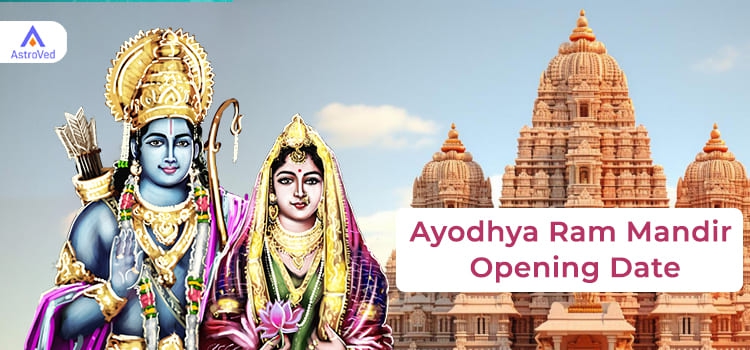Ayodhya Ram Mandir Opening Date
After years of litigation and conflicts, Ayodhya Ram Mandir is about to become a reality in Ayodhya, the birthplace of Maryada Purushottam Ram. Once the long-standing political and religious dispute came to an end, work began at a hectic pace to build the Ram Mandir at Ram Janma Bhumi. The temple will finally open to the public in January 2024. Prime Minister Narendra Modi will inaugurate the temple in the presence of seers and other distinguished guests.
History of Ram Mandir
As per historical records, a temple for Lord Rama existed many centuries ago on this site. Hindus also believe that Rama was born here. As an avatar of Vishnu, Rama is a much-revered deity in India. In the 16th century, Babur, the Mughal emperor, attacked the temple and built a mosque in its place. This was the Babri Masjid mosque. However, in 1992, a Hindu mob destroyed the mosque, leading to violence and communal conflicts.
There were two issues in question – to whom the site belonged and if the site was actually the birthplace of Rama. The Ayodhya dispute continued to fester until the Supreme Court, in 2019, ruled that a temple for Lord Rama could come up on the contested site. Following the verdict, the Shri Ram Janmabhoomi Teerth Kshetra undertook the construction of the temple. It was the Indian government that formed the trust. For Hindus, it was the culmination of a long struggle to set right what they perceive to be a historical wrong.
During the Mughal invasions, many Hindu temples were plundered and pillaged, and several idols of deities had to be hidden or taken to other places to save them from destruction. The loss of religious and cultural heritage has always been a bleeding wound in the Hindu psyche. This wound has begun to heal with the construction of the Ram Janmabhoomi temple.
The bhumi pujan ceremony for starting the construction of Ram Mandir took place on 5 August 2020 by the PM, Narendra Modi. The inauguration of the temple will be on 22 January 2024.
The earliest record of the Babri Masjid mosque goes back to 1767. It is mentioned in the Latin book "Descriptio Indiae," written by the Jesuit missionary Joseph Tiefenthaler. According to his account, the mosque was built by destroying the Ramkot temple, which was supposedly Rama's fortress in Ayodhya, and the Bedi, where Rama’s birthplace is located.
The first incident of religious violence took place in 1853. In December 1858, the British administration prevented Hindus from conducting Pooja at the contested site. Hence, the Hindus built a platform for conducting rituals outside the mosque.

Design and Architecture of the Temple
The Sompura family of Ahmedabad came up with the original design for Ram Mandir in 1988. The family has contributed to the design of more than 100 temples all over the world for at least 15 generations. Among them is the famous Somnath temple. The temple’s chief architect was Chandrakant Sompura, and his sons, Nikhil Sompura and Ashish Sompura (who are also architects), assisted him.
In 2020, the Sompuras prepared a new design with some changes from the original. These were done as per Vastu Shastra and the Shilpa Shastras. The temple will have a width of 250 feet. It will be 380 feet long and 161 feet high. Once the construction is complete, it will be the world's third-largest Hindu temple.
The design is based on the Gurjara-Chaulukya style of Nagara style architecture. One can see this kind of Hindu temple architecture mainly in northern India. In 2019, at the Prayag Kumbh Mela, people got to see a model of the temple.
The temple's main structure will stand on a raised platform with three stories. It will have 5 mandapas in the middle of the garbhagriha (sanctum sanctorum) and the entrance passage. Three mandapas on one side will be of Kudu, Nritya, and Rang, while the two mandapas on the other side will be of Prarthana and Kirtan. As per Nagara style, shikharas will decorate the mandapas.
The building will have 366 columns totally. The latter will have 16 idols, each to include Shiva’s avatars, Vishnu’s Dasavataras, the 64 Chausath Yoginis, and Goddess Saraswati’s 12 incarnations. The sanctum sanctorum will be octagonal. The temple will come up on 10 acres of land, while 57 acres of land will be developed into a complex which includes a lecture hall, a prayer hall, an educational facility, a museum and a cafeteria.
The temple committee claims that more than 70,000 people will be able to visit the temple. For the construction, 600,000 cu ft of sandstone from Baansi in Rajasthan will be used. There will be no use of iron in the temple construction. The fusing of the stone blocks will need 10, 000 copper plates. Interestingly, Thailand is also symbolically contributing to the inauguration of the temple by sending soil to the Ram Janmabhoomi. Earlier, they had sent water from two rivers in Thailand to honor the temple.
Ram Lalla Virajman, Rama’s infant form, is the presiding deity of the temple. The temple’s final blueprint includes shrines for Surya, Ganesha, Shiva, Durga, Vishnu, and Brahma within the temple grounds. Two idols of Ram Lalla (one of them is 5 years old) will occupy the sanctum.
Karnataka-based sculptor Arun Yogiraj is the creator of Rama’s idol.
Consecration Ceremony
Ram Mandir in Ayodhya will be consecrated at 12:20 pm IST on 22 January 2024. Many dignitaries, including spiritual leaders, athletes, movie stars, and businesspersons, will be present on the occasion.
As per Hindu mythology, Rama was born during a confluence of Abhijit Muhurat, Mrigashirsha Nakshatra, Amrit Siddhi Yoga, and Sarvartha Siddhi Yoga. On 22 January 2024, all these auspicious periods will align; hence, it is the ideal date for Pran Pratishtha or the consecration ceremony of the Ram Janmabhoomi Temple.



















